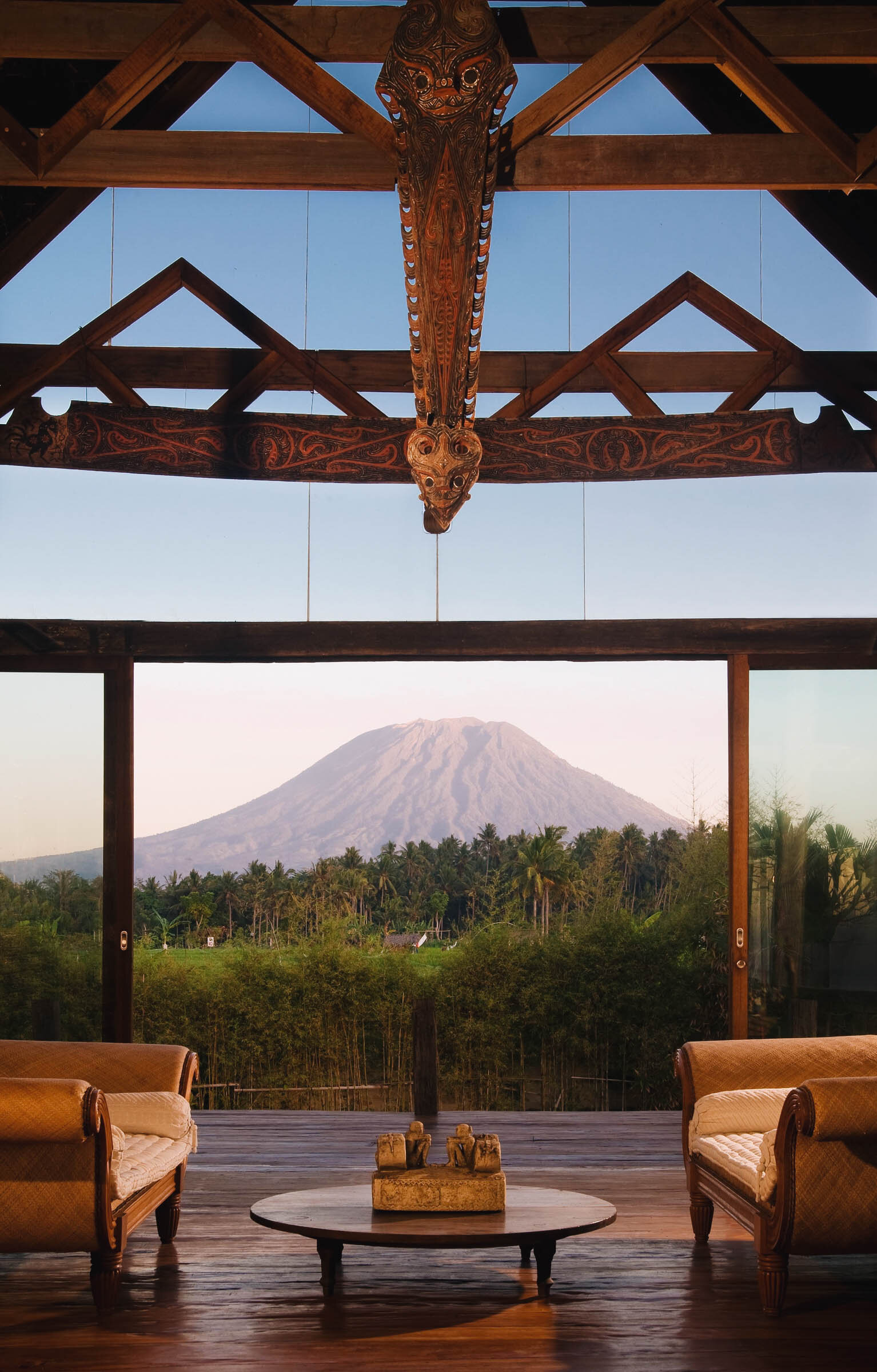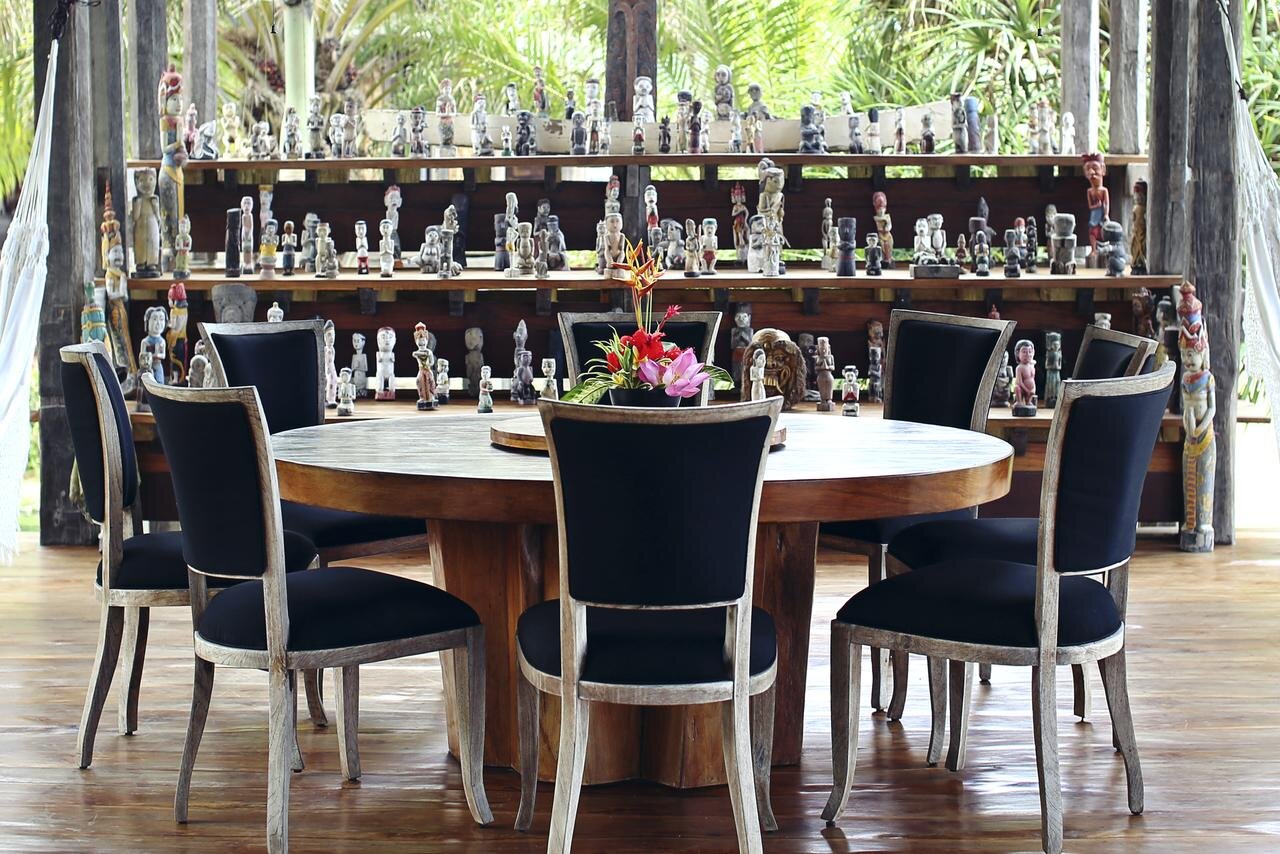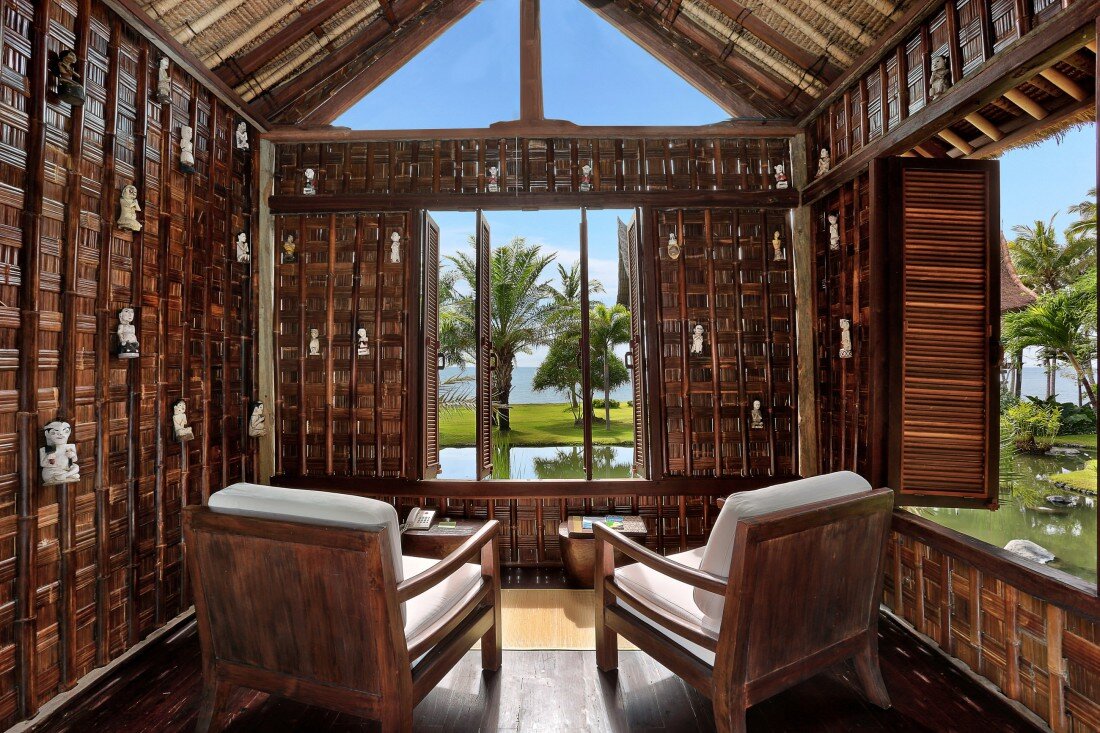The Story of Campuhan
In retrospect, I was not so much drawn to Bali as summoned.
Some force, some cathexis in my own life, lead me there on a surfing trip Christmas, 2002. While searching for manageable waves, I was invited to visit the Tirta Ganga Water Palace near Amlapura by a friend of mine. Half-way there, the landscape changed completely, the congestion and surf-culture madness thinned away. What became clear to me was that this I was now experiencing was ‘BALI ASLI’ the true Bali, villages set in a gentle tropical forest, roosters in bamboo cages set alongside the road, fresh fish warungs, fruit everywhere, baskets still carried on women’s heads, ceremonies spilling out onto the road with all in colorful, elegant traditional dress for the event. People looked happy, with a sense of profound belonging. Their villages, temples, ceremonies, offerings, intricate decorations, and choc-a-block motorbikes bespoke of a powerful culture into which these communities were interwoven to the last detail, even the calendar.
It was magic.
It was during this visit that my friend told me his brother-in-law was selling a beautiful piece of land right on the Lombok Straights, a property divided by the flow of a year-round freshwater river.
I felt compelled to see it.
A long drive down a ‘jalan tannah’ (dirt road) kept begging the question, ‘Why am I doing this?’ When we arrived, the vista along the river to the ocean beyond was so pristine, so vivid in its verdancy, so musical with its riffles and crashing waves, I was swept away. People bathed in the river like they had for thousands of years. The ubiquitous smells of cooking wafted in a heady mix with the clean mineral smell of salt air and graced by the sweet overtones of Arabian jasmine, frangipani and plumeria. Everywhere, palm trees laden with coconuts gently bent with the zephyrs and rattled their fronds as in a welcome.
It was love at first sight.
I walked out to the rocky point where a few small waves were rolling in. The moisture-defused light cascaded on forest and sea alike painting the endless vista with a sensual softness. For contrast, the rugged Saraya mountain range dominated the view north and supplied this constant flow of cool breeze wafting off its slopes.
Then, most spectacularly of all, my eyes set on the mother volcano of Bali, Mount Agung, towering over the terraced rice fields in the distance. Creator and Destroyer, she radiated a power beyond anything a I had ever witnessed. Quiet now, her eruptions over the millennia had given birth to the Island, one black layer at a time. Over time, the rich, volcanic earth gave the Balinese a sustainable agriculture of rice, bananas, coconuts, ‘selak’ (snake fruit), guava, passion fruit, on and on till the tables were rich with color and nutrition.
The Straights were crisscrossed by a thousand fishing boats, their long screw motors and triangular sails dotting the rich waters, handlining mackerel, red snapper, trevally, skipjack, wahoo, and mahi mahi in abundance. Our chefs now visit the fish market 15 minutes away early each morning to buy the freshest and best for our tables. But the beauty of the hollowed-out log boats with their one outrigger supply grace and perspective as they expand out to the horizon in their daily quest for sustenance.
As I took in all this over-whelming beauty, was the rational part of me that kept stressing ‘this is a long way from Los Angeles’ where I lived. But it was the irrational part of me that extended its tendrils all over my judgement and wrestled all doubts to the ground.
I was going with my heart.
I had been summoned for a reason and this was it. I bought the land right then and there. When I asked my new Balinese partner Wayan Suwita (a foreigner can only buy land in Bali with a Balinese partner and I was lucky to bond with this amazing man), “what do you call where the river meets the sea?” He replied, “campuhan.”
I decided that would be the name, VILLA CAMPUHAN.
For the next two years, I lived on the land and absorbed as much as it could teach me. I made friends with my neighbors, Balinese and ex-pats alike. I became involved with the Desa, the village council, the Sobek, the water management board and roasted many a ‘babi guling’ in feasts to celebrate birthdays, holidays, or just for fun. Bintang beer and spit roasted meat can be a heady mix under the stars. All the while I was forming some ideas of how I wanted to honor this land.
And then I met internationally famous designer Linda Garland and knew instantly she was the link to the future of Villa Campuhan.
A regular in Architectural Digest, her work was sourced in an Indonesian aesthetic that took in Balinese culture as well as many others along the archipelago. Her home ‘Panchoran’ was a masterpiece which I visited often and was always subsumed by its peace and nurturing sense of well-being. I asked her to join forces to do something special with this amazing location I had found, to honor and preserve its beauty.
When we met in her ‘Bridge House,’ a dwelling spanning the Ayung River near Ubud, I told her I wanted to build a village, eco-responsible in all aspects, built with recycled wood, where friends, guests and local community can intermingle in harmony.
She committed her immense talent and energy to this vision.
She found a young architect, Maya Buxton, who had just come back from the highlands of Western Sumatra where she had studied the architecture of the Minangkabau tribe, a matrilineal, Moslem people who developed a style of ‘long house’ built without nails, screws, or any metal whatsoever. In studying the blueprints, Linda and I knew intuitively this was the direction we were seeking. Linda knew of caches of hundred-year old used ironwood electrical poles that were stockpiled around the island. It took six months of detective work to actually find them but finally we succeeded. We bought 400 members, a fine re-cycled resource, some as long as 30 feet from which we would build all the 5 structures, four villas and a 2500 square foot central living room/dining room, the common area for all to share.
I sent Maya and Linda to Sumatra to meet with the Minang people and see if there were some carpenters who would be willing to spend six months in Bali building our project. To our surprise, Pak Cap, the master carpenter and crew chief, told us part of the Minang culture is for its people to journey into the world and bring back what they had learned to the tribe. We engaged the 15 carpenters Pak Cap felt he needed.
For the next six months, Pak Cap and his cohorts spread the huge ironwood poles on the ground and began cutting ‘tongues and grooves’ in the members. Cap would use the spread between his pinky and his extended thumb to mark off the intervals and would mark the spot for a groove with a piece of chalk. No tape measures were ever used. The carpenters cut into the enormously hard beams using only wooden mallets and chisels.
As this went on, month after month six days a week, I began to worry I had lost my mind in pursuit of this dream. Each morning, the Minang would extend their prayer rugs and pray to Mecca. All through the day, the Moslem Minang worked alongside our Balinese Hindu workers building foundations, water lines, etc. in perfect harmony. Never an angry word or a bad look. Thus, quiet, respectful productivity was infused into the DNA of each house.
Just when I thought another day of chiseling would drive me crazy, Pak Cap came to me, with his omni-present cigarette in hand, and said that the first house would be up by lunch.
It seemed impossible. Using bamboo poles lashed to the ironwood as leverage and a series of hastily built platforms, the tongues were slipped into the grooves and the structure began to take shape.
There are no right angles in a Minangkabau long house. They are built more like boats than western structures, the idea being that the stress loads should push inward at approximately 37 degrees from the triple roof and be set on large flat stones unfastened to any foundation. This flexibility spreads through the joinery so that, in case of an earthquake, more common to Sumatra than Bali, the house actually ‘dances’ in place, the loads being shifted effortlessly as the earth shifts and the structure compensates. The vast destruction associated with earthquakes around the world has to do with the rigidity of western architecture and its inability to shift when the seismic activity rolls through.
By lunch, as Cap promised, the first long house structure was standing, roofless, floorless but standing.
Linda and I spent hours on a platform siting Villa Agung so that the distant volcano would be perfectly centered in the huge glass wall that would form the back wall of the house. When it went up in the following days, the result was arithmetically and aesthetically perfect.
Hand-hewn teak floors were installed, boards cut lengthwise from the licensed tree and then skillfully seamed together so you can actually see the cross-section of the tree that became the most elegant of floors. Again, no nails, no screws, no metal fasteners of any sort.
The material the Minang use for their soaring rooves in the shape of cattle horns was a black coconut fiber but in Bali, the priests would not allow this as this fiber is used in various spirit houses and has a religious connotation. We honored that decision and used a local grass known as ‘Alang-Alang’ for our rooves, the result being most pleasing. Such cross-cultural instances are common in this rich, multi-ethnic part of the world.
I went to the Sobek, or Water Council, to discuss the feasibility of having an aqua-culture pond that Linda and I planned for the center of the four structures. All water in Bali is controlled by such councils as water is the quintessential element of rice farming, the main agricultural crop of Bali. After looking at our site maps and plans, they conferred among themselves and came back to me with a decision, as long as the water from the fresh-water river returned to the sea, it was good with them.
Linda and I met in Amsterdam to visit the best Indonesian Museums in the world, the Dutch having colonized the archipelago for over 300 years. The Tropenmuseum housed the finest hand-woven fabrics, furniture, Kris’s (ceremonial knives), rumbi’s (rice storage barrels), vintage photographs etc. the true core of Indo culture before the complete dissolution by Western influence. Here Linda was in her element forming a vision of how the interiors of each long house would appear. I was thrilled by all her ideas.
My favorite was her idea to go to Sumba, another island, and rebuild their ancient looms so that these extinct fabric patterns could be recreated by contemporary weavers in these small villages. Especially the older women still had memories of these long-ago patterns. Thus, all the fabric for Villa Campuhan were woven by these collectives like ‘Threads of Life’ still functioning today.
In the meantime, she and I gathered some of the finest Indonesian antiques and Minangkabau architectural pieces available working with John Strasinski and his Primary Source Gallery as well as antique dealers all over Bali. Linda designed the furniture and little by little, each house became a home with a strong sense of regional and tribal history.
I saw a beautiful carving of man about 12 inches high while dining in nearby Candi Dasa one evening. It was crude yet amazingly specific. I asked if they had any more. They said no, they had bought this one from a French Anthropologist who lived up country with the mountain tribes in Northern Bali. After some searching, we connected. These ‘Bali Akah’ or ancient Balinese carvings were meant to be portraits of specific people, ancestors who after death, would remain in the memories of their families and loved ones by housing these carvings. I bought all 700 from him as I wanted this extensive collection to stay together. Today, all the villas are populated with these sculptures. In fact, they were the first residents of Villa Campuhan and help give the place its unique energy. They are a tribe within a tribe of we the living who can savor the beauty and cultural richness all around us.
By 2005, it was all finished and ready to occupy. I learned about a ceremony of transformation that the Balinese do when a new house is built, called the ‘malas pas.’ I invited the entire village and the priest dug a hole in the exact center of the property. In this he placed pieces of ironwood, bunches of grass, some stones explaining that the ceremony is to honor the way in which these simple materials had become shelters, homes, centers for friends and family, a sense of place, a sense of belonging.
This was all I had sought and more. Adding some western amenities like two pools, spas, kitchens, laundries, staff housing and offices, Villa Campuhan became the perfect cross between environmental integration, eco-consciousness, and the spirituality with which it was built. I have been all over the world and there is much beauty everywhere but no place I ever visited had the potent force, the magic and the mystery of our village where the river meets the sea.







